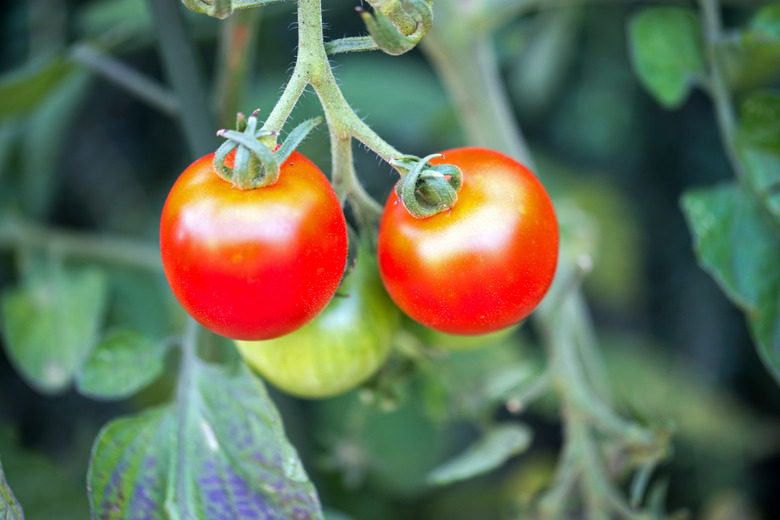Will Deer Eat Tomato Plants?
Deer are hungry creatures and, according to the Oregon State University Extension Office, they will eat more than 500 different types of plants — including your tomato plants (Solanum lycopersicum, hardy in U.S. Department of Agriculture plant hardiness zones 8 through 11). Unfortunately for home vegetable gardeners, it isn't just the fruits of the plants that suffer. Deer cause damage to the whole plant, from the stems to the leaves and occasionally even the roots. Identifying deer damage and taking steps to prevent deer from feasting on your vegetable garden are the best ways to keep your tomato plants whole and healthy.
Identifying Damage
When deer bite tomatoes, the damage is very often at the top of the fruit. You might also find that nearby plants are trampled, leaves are bitten off and stems and stalks are bitten down to the ground, with a serrated edge left behind rather than a smooth cut. Raccoon damage can sometimes mimic the effects of deer damage, but the differentiating features are the scene of the crime — rarely do raccoons cause as much damage to the surrounding area as deer. It can be tough to identify deer damage, as they often chow down on tomato plants at dawn or late in the evening.
Barrier Methods
A hungry deer is not a creature that respects property boundaries. A determined deer can easily jump a 6-foot-tall fence without so much as batting an eye — and installing a fence that high is inconvenient and burdensome for the backyard gardener. But you can outsmart the hordes of hungry deer by placing individual cages made of chicken wire or mesh around each tomato plant. Make sure the cage has a top cover, or else your work will be in vain.
Scent Matters
Deer rely on scent to find their food sources — you can outsmart them by confusing their sense of smell. Human-scented items like old T-shirts, clumps of hair or old shoes can give your garden the odor of people and deter most deer. Scented soaps strung up around the border of your garden can also act as deer repellent. If you own a dog — or can borrow one — have it urinate around the border of the garden, which can also be a strong deterrent toward most deer. You can also try mixing up about four eggs with 5 gallons of water and spraying the mixture around the garden with a pressure sprayer — while the odor is hardly noticeable to humans, the smell is strong enough for a deer's sensitive nose to detect and make the area unpleasant.
Planting for -- and Against -- Deer
When it comes down to it, a hungry deer is not going to be deterred and will eat almost anything, no matter what obstacles come between it and its food. Some gardeners have had success planting a plot specifically for the deer with deer-attractive plants — yes, including tomatoes. The idea of planting just for the deer is that they can eat their fill from that plot and will — in conjunction with other deterrent methods — leave your prized tomato plants alone.
Another option is to plant deer-repellent plants around the border of your vegetable plot. Japanese boxwood (Buxus microphylla japonica, hardy in USDA zones 6 to 11); rosemary (Rosmarinus officinalis, hardy in USDA zones 6 through 9); purple fountain grass (Pennisetum setaceum, hardy in USDA zones 9 through 10); and zinnias (Zinnia spp., hardy in USDA zones 2 through 11) are just some examples of deer-repellent plants you can place around the border of your garden to deter deer.
References
- Texas A&M AgriLife Extension: Deer in the Urban Landscape
- NC State University Cooperative Extension: Is There Anything Deer Will Not Eat?
- Michigan State University Extension: When Bad Things Happen to Good Tomatoes
- ProIPM: Deer Damage Control For Landscape Plants (PDF)
- Plants for a Future: Tomato
- Arizona State University: Japanese Boxwood
- The Old Farmer's Almanac: Rosemary
- Missouri Botanical Garden: Purple Fountain Grass
- Missouri Botanical Garden: Zinnia
